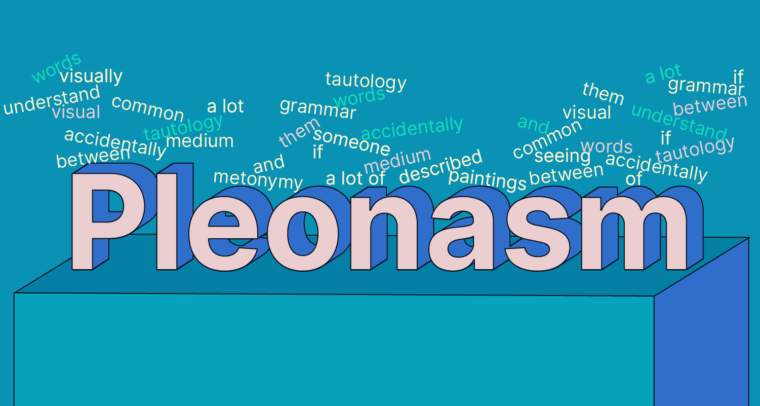
Pleonasm means using more words than are necessary. Pleonasm shows up in phrases like “I saw it with my own eyes” (who else’s eyes could have seen it for you?), “buy now for an added bonus” (a bonus is by definition additional), and “receive a free gift” (gifts are always free). Once you start to understand pleonasms, you will see them pop up everywhere.
What is pleonasm?
The definition of pleonasm (pronounced plee-uh-naz-uhm) is “the use of more words than necessary to denote mere sense.” Its meaning comes from the Greek word pleonazein, which means “to be excessive.”
As a writer, you should be conscious of how often you use pleonasms. A few pleonasms sprinkled throughout the text provide strategic emphasis, but too many accidental pleonasms make your writing look unpolished.
What are the two types of pleonasm?
1 Syntactic pleonasm
Syntactic pleonasm is a redundancy that is grammatical in nature. For example, double negatives are syntactic pleonasms.
“I don’t see why not” is an example of syntactic pleonasm since the same thing could easily be expressed in one word: “Sure.”
2 Semantic pleonasm
Semantic pleonasm is a redundant description or idea. For example, a menu that offers a “blended smoothie” is also, inadvertently, offering a pleonasm. Smoothies are, by definition, blended fruit drinks.
Pleonasms are common in everyday speech, so some of these phrases might not sound awkward to you. Using pleonasms isn’t inherently good or bad; in fact, some writers even use pleonasms on purpose.
Pleonasms in writing
Although pleonasm should generally be avoided in writing, in some instances a writer might choose to purposely use pleonasm for emphasis or convincing dialogue.
For example, “I saw it with my own eyes” is a pleonasm because the word saw implies that the action was done with one’s eyes. It is more concise to say, “I saw it,” or “I saw it happen.”
However, we understand the phrase “I saw it with my own eyes” to mean that the listener is in some state of disbelief. Using pleonasm in this instance is useful to convey that the character just witnessed something remarkable.
It’s common to accidentally find pleonasms throughout your writing since they are so prevalent in spoken English. That’s why it is important to proofread before you submit. Grammarly’s conciseness suggestions can help you with this process.
Pleonasm vs. tautology vs. metonymy
There are a number of literary devices that are related to conciseness in your writing. One of these devices is pleonasm. Other terms you might encounter are tautology and metonymy.
Pleonasm is the use of too many words.
This is pleonasm because paintings are a visual medium. If you describe them as ornate, it is already implied that they are visually ornate.
Tautology in writing is the use of two (or more) words that convey the same meaning.
This is tautology since imagining is a mental action. Tautology is a type of pleonasm but refers specifically to using words with the same meaning.
These tautologies are slightly different from logical tautologies, statements that are true under every possible circumstance.
Metonymy is a literary device wherein one word is replaced with a closely related word. While pleonasm and tautology place related words together in a sentence, metonymy swaps words out for one another. An example of metonymy is using Wall Street in your writing as a stand-in for the financial sector.
Pleonasm and tautology are literary devices where a writer uses too many words—sometimes intentionally. Metonymy is one technique to help you cut down on this wordiness.
Pleonasm examples
- added bonus
- exact replica
- foreign imports
- free gifts
- frozen ice
- regular routine
- unexpected surprise
- past history
Pleonasm FAQs
What is a pleonasm?
Pleonasm is the excessive use of words. An example of pleonasm is “a burning hot fire,” since fire is burning hot by definition. Occasionally, writers purposely use pleonasm to add emphasis.
What are the different kinds of pleonasm?
Syntactic pleonasm is using excessive words within a sentence structure without adding any meaning. For example, a double negative like “I can’t not look” is a syntactic pleonasm.
Semantic pleonasm is the use of excessive words to describe something. For example, “ice-cold drink” is a semantic pleonasm because ice is always cold.
What’s the difference between pleonasm and tautology?
A pleonasm is any excessive use of words in writing. A tautology is the use of two (or more) words that mean the same thing.






